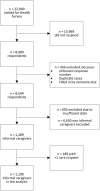Factors associated with caregiver burden among adult (19-64 years) informal caregivers - An analysis from Dutch Municipal Health Service data
- PMID: 32207221
- PMCID: PMC7496310
- DOI: 10.1111/hsc.12982
Factors associated with caregiver burden among adult (19-64 years) informal caregivers - An analysis from Dutch Municipal Health Service data
Abstract
Due to the ageing population and the rising prevalence of chronic diseases, it is expected that the demand on informal caregivers will increase. Many informal caregivers experience burden, which can have negative consequences for their own health and that of the care recipient. To prevent caregiver burden, it is important to investigate factors associated with this burden. We aimed to identify factors associated with caregiver burden in adult informal caregivers. Among a sample of adult informal caregivers (n = 1,100) of the Dutch region of Zaanstreek-Waterland, perceived caregiver burden, demographic factors, caregiving situation, health-related factors and socio-financial factors were measured as part of the national Health Survey in 2016. Using univariate and multivariate logistic regression analysis, for which a backward selection method was applied, associations with caregiver burden were studied. In the multivariate model, time spent providing informal care was significantly associated with perceived caregiver burden, with an odds ratio (OR) [95% confidence interval] of 7.52 [3.93-14.39] for those spending >16 hr compared to 1-2 hr on informal care. Also providing care to their child(ren) (OR: 2.55 [1.51-4.31]), poor perceived health (OR: 1.80 [1.20-2.68]) and loneliness of the caregiver (OR: 2.05 [1.41-2.99]) were significantly associated with caregiver burden. To possibly prevent and reduce informal caregiver burden, factors associated with such burden should be intervened on. As such, special attention should be paid to caregivers who provide many hours of care or provide care to their child(ren), as well as those who have a poor perceived health themselves and/or experience feelings of loneliness.
Keywords: cross-sectional; health survey; informal care; informal caregivers; perceived burden.
© 2020 The Authors. Health and Social Care in the Community published by John Wiley & Sons Ltd.
Conflict of interest statement
The authors declare no conflicts of interest.
Similar articles
-
Geographical location as a determinant of caregiver burden: a rural-urban analysis of the informal caregiving, health, and healthcare survey in Ghana.BMC Prim Care. 2024 Aug 28;25(1):317. doi: 10.1186/s12875-024-02562-7. BMC Prim Care. 2024. PMID: 39198724 Free PMC article.
-
Positive and negative outcomes of informal caregiving at home and in institutionalised long-term care: a cross-sectional study.BMC Geriatr. 2017 Oct 10;17(1):232. doi: 10.1186/s12877-017-0620-3. BMC Geriatr. 2017. PMID: 29017453 Free PMC article.
-
Gender Differences in Mental Health, Quality of Life, and Caregiver Burden among Informal Caregivers during the Second Wave of the COVID-19 Pandemic in Germany: A Representative, Population-Based Study.Gerontology. 2023;69(2):149-162. doi: 10.1159/000523846. Epub 2022 Apr 7. Gerontology. 2023. PMID: 35390788 Free PMC article.
-
Subjective caregiver burden and anxiety in informal caregivers: A systematic review and meta-analysis.PLoS One. 2021 Mar 1;16(3):e0247143. doi: 10.1371/journal.pone.0247143. eCollection 2021. PLoS One. 2021. PMID: 33647035 Free PMC article.
-
Experiences of informal caregivers supporting individuals with upper gastrointestinal cancers: a systematic review.BMC Health Serv Res. 2024 Aug 14;24(1):932. doi: 10.1186/s12913-024-11306-3. BMC Health Serv Res. 2024. PMID: 39143501 Free PMC article.
Cited by
-
Psychometric validation of the Thai version of the 12-item Zarit Burden Interview among informal caregivers in a palliative care setting in the south of Thailand.PLoS One. 2025 May 15;20(5):e0322852. doi: 10.1371/journal.pone.0322852. eCollection 2025. PLoS One. 2025. PMID: 40373099 Free PMC article.
-
Factors Associated with Quality of Care Among Dependent Older Persons in the Community.J Multidiscip Healthc. 2021 Sep 21;14:2651-2655. doi: 10.2147/JMDH.S323851. eCollection 2021. J Multidiscip Healthc. 2021. PMID: 34588780 Free PMC article.
-
Sleep Quality Among Informal Caregivers During the COVID-19 Pandemic: A Cross-Sectional Study.Gerontol Geriatr Med. 2022 Jan 6;8:23337214211057387. doi: 10.1177/23337214211057387. eCollection 2022 Jan-Dec. Gerontol Geriatr Med. 2022. PMID: 35024381 Free PMC article.
-
Resilience and prosocial behaviour in Spanish care professionals of dependent persons.Health Soc Care Community. 2022 Nov;30(6):e6613-e6621. doi: 10.1111/hsc.14110. Epub 2022 Nov 22. Health Soc Care Community. 2022. PMID: 36412062 Free PMC article.
-
Development of a novel COMPAssion focused online psyChoTherapy for bereaved informal caregivers: the COMPACT feasibility trial protocol.BMJ Open. 2022 Dec 22;12(12):e067187. doi: 10.1136/bmjopen-2022-067187. BMJ Open. 2022. PMID: 36549732 Free PMC article.
References
-
- Allen, I. E. , & Seaman, C. (2007). Likert scales and data analyses. Quality Progress, 40(7), 64–65.
Publication types
MeSH terms
LinkOut - more resources
Full Text Sources
Medical
Research Materials


